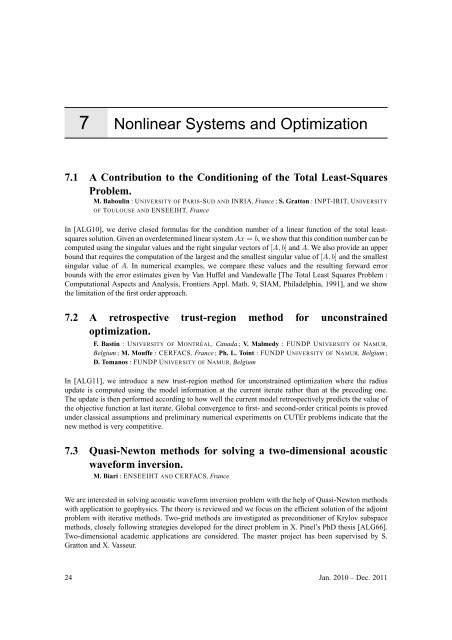CERFACS CERFACS Scientific Activity Report Jan. 2010 â Dec. 2011
CERFACS CERFACS Scientific Activity Report Jan. 2010 â Dec. 2011
CERFACS CERFACS Scientific Activity Report Jan. 2010 â Dec. 2011
Create successful ePaper yourself
Turn your PDF publications into a flip-book with our unique Google optimized e-Paper software.
7 Nonlinear Systems and Optimization<br />
7.1 A Contribution to the Conditioning of the Total Least-Squares<br />
Problem.<br />
M. Baboulin : UNIVERSITY OF PARIS-SUD AND INRIA, France ; S. Gratton : INPT-IRIT, UNIVERSITY<br />
OF TOULOUSE AND ENSEEIHT, France<br />
In [ALG10], we derive closed formulas for the condition number of a linear function of the total leastsquares<br />
solution. Given an overdetermined linear system Ax = b, we show that this condition number can be<br />
computed using the singular values and the right singular vectors of [A,b] and A. We also provide an upper<br />
bound that requires the computation of the largest and the smallest singular value of [A,b] and the smallest<br />
singular value of A. In numerical examples, we compare these values and the resulting forward error<br />
bounds with the error estimates given by Van Huffel and Vandewalle [The Total Least Squares Problem :<br />
Computational Aspects and Analysis, Frontiers Appl. Math. 9, SIAM, Philadelphia, 1991], and we show<br />
the limitation of the first order approach.<br />
7.2 A retrospective trust-region method for unconstrained<br />
optimization.<br />
F. Bastin : UNIVERSITY OF MONTRÉAL, Canada ; V. Malmedy : FUNDP UNIVERSITY OF NAMUR,<br />
Belgium ; M. Mouffe : <strong>CERFACS</strong>, France ; Ph. L. Toint : FUNDP UNIVERSITY OF NAMUR, Belgium ;<br />
D. Tomanos : FUNDP UNIVERSITY OF NAMUR, Belgium<br />
In [ALG11], we introduce a new trust-region method for unconstrained optimization where the radius<br />
update is computed using the model information at the current iterate rather than at the preceding one.<br />
The update is then performed according to how well the current model retrospectively predicts the value of<br />
the objective function at last iterate. Global convergence to first- and second-order critical points is proved<br />
under classical assumptions and preliminary numerical experiments on CUTEr problems indicate that the<br />
new method is very competitive.<br />
7.3 Quasi-Newton methods for solving a two-dimensional acoustic<br />
waveform inversion.<br />
M. Biari : ENSEEIHT AND <strong>CERFACS</strong>, France<br />
We are interested in solving acoustic waveform inversion problem with the help of Quasi-Newton methods<br />
with application to geophysics. The theory is reviewed and we focus on the efficient solution of the adjoint<br />
problem with iterative methods. Two-grid methods are investigated as preconditioner of Krylov subspace<br />
methods, closely following strategies developed for the direct problem in X. Pinel’s PhD thesis [ALG66].<br />
Two-dimensional academic applications are considered. The master project has been supervised by S.<br />
Gratton and X. Vasseur.<br />
24 <strong>Jan</strong>. <strong>2010</strong> – <strong>Dec</strong>. <strong>2011</strong>
















